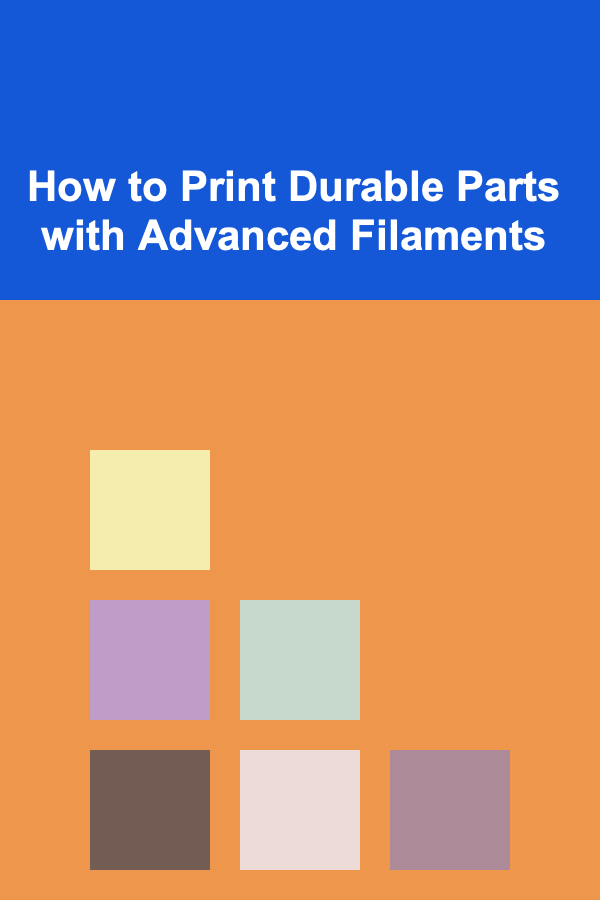
How to Print Durable Parts with Advanced Filaments
ebook include PDF & Audio bundle (Micro Guide)
$12.99$7.99
Limited Time Offer! Order within the next:

3D printing has come a long way since its inception, with applications spanning from prototypes to end-use parts in industries like automotive, aerospace, and medical devices. The key to enhancing the utility and longevity of 3D-printed parts lies in the materials used, specifically advanced filaments. These filaments provide the durability, strength, and heat resistance needed for parts to withstand real-world applications. In this article, we will dive deep into the world of advanced filaments, examining the types of filaments available, their unique properties, and how you can use them to print durable parts.
The Importance of Durable 3D Printed Parts
Before we explore advanced filaments, it's important to understand why durability is crucial in 3D printing. Traditional manufacturing techniques, such as injection molding or machining, often produce parts that are incredibly robust, resistant to wear and tear, and able to withstand environmental stresses. 3D printing, on the other hand, has historically been associated with prototyping and low-strength parts. However, with the advent of advanced filaments and new printing technologies, it is now possible to produce parts that not only match but sometimes exceed the performance of traditionally manufactured parts in specific applications.
Durability is essential in a wide variety of industries, from aerospace, where parts must endure extreme temperatures and high-stress conditions, to automotive, where components must withstand constant wear and vibration. In fields like medical device manufacturing, durable 3D-printed parts can help create long-lasting tools or implants, improving patient care and reducing the frequency of replacements.
Types of Advanced Filaments
The range of advanced filaments available today is vast, each offering unique properties that can help improve the performance of 3D printed parts. Here are some of the most popular advanced filaments and the specific benefits they provide:
1. Polycarbonate (PC)
Polycarbonate is a high-strength thermoplastic known for its toughness, heat resistance, and impact resistance. It is often used in industries that require parts to withstand high temperatures and mechanical stress. Polycarbonate has a glass transition temperature of around 150°C, meaning it can maintain its structural integrity in temperatures much higher than standard PLA or ABS filaments.
Key Characteristics:
- High impact resistance
- Excellent thermal stability (up to 150°C)
- Good optical clarity (can be transparent)
- High strength-to-weight ratio
Applications: Automotive components, protective covers, electrical components, and even medical devices like prosthetics.
2. Nylon (PA)
Nylon is known for its excellent strength, flexibility, and resistance to wear and tear. It is often used in applications requiring parts that need to endure constant friction, such as gears, bearings, and other moving components. Nylon also has good chemical resistance, making it suitable for environments with exposure to oils, fuels, and solvents.
Key Characteristics:
- High tensile strength
- Flexibility and wear resistance
- Good resistance to chemicals and oils
- Can absorb moisture, which affects print quality if not stored properly
Applications: Automotive, robotics, consumer goods, and parts exposed to high wear environments.
3. Carbon Fiber Reinforced Filaments
Carbon fiber reinforced filaments are usually a blend of PLA, ABS, Nylon, or PETG, mixed with carbon fiber strands. These filaments offer exceptional strength, stiffness, and lightweight properties, making them perfect for parts that need to be both durable and light. Carbon fiber filaments are ideal for producing parts that require a high level of structural integrity while minimizing the overall weight.
Key Characteristics:
- Extremely high strength-to-weight ratio
- Superior stiffness and rigidity
- Excellent for high-performance applications
- Abrasive to nozzles, requiring hardened steel or ruby tips
Applications: Aerospace, automotive, drones, and structural parts in industrial machines.
4. PEEK (Polyether Ether Ketone)
PEEK is one of the highest-performing thermoplastics available for 3D printing. It is known for its outstanding chemical resistance, high temperature stability, and mechanical properties. PEEK can endure temperatures up to 250°C, making it ideal for extremely demanding applications such as in the aerospace, medical, and automotive industries. However, PEEK requires a heated chamber for printing, which makes it one of the more difficult filaments to work with.
Key Characteristics:
- High temperature resistance (up to 250°C)
- Exceptional chemical and wear resistance
- High strength and stiffness
- Expensive and requires specialized 3D printers
Applications: Aerospace, automotive, medical implants, and industrial applications requiring high-performance parts.
5. Ultem (PEI - Polyetherimide)
Ultem, also known as PEI, is a high-performance thermoplastic similar to PEEK but typically more affordable. It has excellent mechanical properties, thermal stability, and is highly resistant to chemicals. Ultem is often used in industries like aerospace and medical device manufacturing where reliability and performance are critical.
Key Characteristics:
- High heat resistance (up to 200°C)
- Excellent chemical resistance
- High strength and dimensional stability
- Requires a heated bed and high extrusion temperatures
Applications: Aerospace components, automotive, medical devices, and high-stress industrial parts.
6. PETG (Polyethylene Terephthalate Glycol)
PETG is a popular filament because it strikes a balance between ease of use, strength, and durability. PETG is resistant to impact, has good temperature resistance (up to 80°C), and is relatively easy to print compared to other advanced filaments. It also has good chemical resistance, making it suitable for environments where exposure to water, alcohols, or mild acids is common.
Key Characteristics:
- Good strength and flexibility
- Impact resistant and durable
- Moderate temperature resistance
- Low shrinkage and minimal warping
Applications: Household items, containers, mechanical parts, and products used in food and beverage industries.
Preparing for Printing with Advanced Filaments
Once you have selected the appropriate advanced filament for your project, it's important to prepare both your 3D printer and the filament itself to achieve the best results. Here are some preparation tips:
1. Printer Compatibility
Advanced filaments often require specialized 3D printers capable of handling high temperatures and different extrusion methods. For example:
- Heated beds: Many advanced filaments, like Nylon, PEEK, and Ultem, require heated beds to prevent warping and to maintain adhesion.
- Hotend temperature: Filaments like PEEK and Polycarbonate require high extrusion temperatures, usually over 250°C, which means your printer's hotend must be capable of reaching these temperatures.
- Enclosed build chamber: For filaments that are sensitive to environmental conditions (like Polycarbonate and Nylon), an enclosed build chamber can help maintain a stable temperature, minimizing warping or cracking during printing.
2. Drying the Filament
Some advanced filaments, such as Nylon, absorb moisture from the air, which can affect the print quality and lead to issues like bubbling, poor layer adhesion, or even nozzle clogs. Therefore, it's essential to store your filament in airtight containers with desiccants and, if necessary, dry it before printing. You can use a filament dryer or an oven at a low temperature to remove excess moisture from the filament.
3. Nozzle and Print Surface Preparation
Certain filaments, particularly carbon fiber reinforced filaments, can be abrasive and will quickly wear down standard brass nozzles. Consider switching to a hardened steel or ruby nozzle to extend the life of your printer. Additionally, depending on the filament you're using, you might need to apply specific adhesives to the print bed to ensure proper adhesion and avoid warping.
4. Adjusting Print Settings
Each advanced filament comes with its own set of optimal print settings. For instance:
- Extrusion temperature: Refer to the manufacturer's recommended extrusion temperature, which can vary based on the filament type (typically between 220°C and 300°C).
- Print speed: Slower print speeds (around 30-50mm/s) are often preferred for advanced filaments to ensure that the material flows smoothly and adheres properly.
- Layer height: A smaller layer height (around 0.1mm to 0.2mm) can improve print quality, especially for high-detail parts.
Post-Processing for Durability
To further improve the durability of 3D printed parts, post-processing can be applied. Post-processing can help enhance the mechanical properties, finish, and overall performance of your printed parts.
1. Annealing
Annealing is the process of heating your printed parts to a temperature just below their glass transition temperature and allowing them to cool slowly. This helps to relieve internal stresses and can increase the strength and heat resistance of the part, especially when using materials like Nylon or Polycarbonate.
2. Surface Treatments
In some cases, you may want to improve the surface properties of your printed parts to make them more resistant to wear or to achieve a specific finish. Methods such as sanding, chemical smoothing (using chemicals like acetone for ABS), or coating with protective layers (like epoxy resin or polyurethane) can help achieve this.
3. Incorporating Support Structures
For certain applications, especially in highly demanding environments, incorporating internal support structures (such as lattice or honeycomb patterns) can increase the part's overall strength without adding significant weight. This can be done using software tools to design lightweight but durable parts.
Conclusion
The ability to print durable parts with advanced filaments opens up a world of possibilities for industries that demand high-performance 3D printed components. By understanding the different advanced filaments, their properties, and how to optimize the 3D printing process, you can create parts that are not only functional but also highly reliable in real-world applications.
While the process of printing with advanced filaments can be more challenging compared to standard filaments, the results can be well worth the effort. With careful preparation, the right equipment, and the proper post-processing techniques, you can harness the power of advanced filaments to create strong, durable parts for virtually any application. As 3D printing technology continues to evolve, the materials available will become even more versatile, providing endless opportunities for innovation across industries.

How to Build a Checklist for Post-Disaster Incident Review and Reporting
Read More
How to Keep Your Home's Lawn Irrigation System Running Smoothly
Read More
How to Set Up an Efficient Order Fulfillment System for Automotive Products
Read More
Mastering Negotiation: The Art of Closing Deals in the World of Real Estate
Read More
Learning to Speedfly: A Comprehensive Guide to Mini Paragliding
Read More10 Tips for Troubleshooting Common Habit Tracker Planner Problems
Read MoreOther Products

How to Build a Checklist for Post-Disaster Incident Review and Reporting
Read More
How to Keep Your Home's Lawn Irrigation System Running Smoothly
Read More
How to Set Up an Efficient Order Fulfillment System for Automotive Products
Read More
Mastering Negotiation: The Art of Closing Deals in the World of Real Estate
Read More